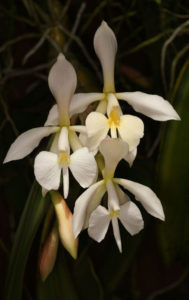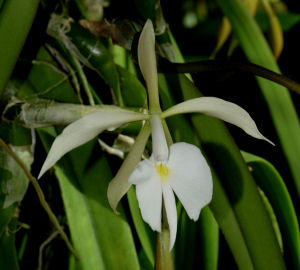The following article was written for the Orchid Species Bulletin published by the Orchid Species Society, which is based in Brisbane, Queensland in December 2006.
Bear in mind that any cultivation notes refer to the subtropical conditions of Southern Queensland, Australia.
 Coilostylis falcata (Lindl.) Withner & Harding was first described by John Lindley as Epidendrum falcatum in the Annals and Magazine of Natural History in 1840. The specific epithet comes from the Latin falcatus (sickle-shaped) for the leaves. Carl Withner and Patricia Harding transferred this species to the resurrected genus Coilostylis Raf. in The Cattleyas and Their Relatives – The Debatable Epidendrums in 2004.
Coilostylis falcata (Lindl.) Withner & Harding was first described by John Lindley as Epidendrum falcatum in the Annals and Magazine of Natural History in 1840. The specific epithet comes from the Latin falcatus (sickle-shaped) for the leaves. Carl Withner and Patricia Harding transferred this species to the resurrected genus Coilostylis Raf. in The Cattleyas and Their Relatives – The Debatable Epidendrums in 2004.
A creeping lithophytic brittle plant, Coil. falcata has tough pseudobulbs that are bone along a thick coarse woody rhizome. Each cylindrical to spindle-shaped pseudobulb is 4-15 cm long and 8-25 mm in diameter with a single apical leaf. Long and channelled, the fleshy-leathery sickle-shaped or narrowly linear-lanceolate leaf is 10-40 (-55) cm long and 1.5-5 cm broad. Short apical umbel-like inflorescences that are up to 3.5 cm long bear (2-) 4-8 (-10) flowers that open simultaneously. The raceme emerges from a long pale yellowish green membranous sheath that is up to 3.5 cm long.
Large and showy, the starry flowers of Coil. falcata are 6-8.5 cm across and are borne on very long pedicellate ovaries that are (7-) 9-12 cm. The flowers have pale yellowish to white sepals that are suffused pink on the outer surface. The petals, column and lip are white and the lip has a yellow callus. Its long-lasting flowers produce a strong sweet soapy or jasmine-like fragrance at night.

Endemic to Mexico, Coil. falcata is distributed in the states of Durango, Sinaloa, Guerrero, Oaxaca and Puebla. Plants grow on limestone rocks and cliffs in pine and oak forests, as well as in xerophytic shrub and thorn forests between 1,000-2,100 m altitude.
An intermediate-growing species, Coil. falcata requires a coarse or well-drained medium and a hanging basket or tray to accommodate its rambling growth habit. Grow it under 50-70% shade with good air circulation at all times. Maintain high humidity during the warmer months and water it regularly while it is actively growing. Give it a cooler drier winter rest with occasional misting or water on sunny mornings to prevent the plant from shrivelling. The roots should be allowed to dry between waterings during the cooler months.
